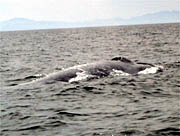

TODAY'S WEATHER
Sunny
62°F
(16.7°C)
Latitude:
27deg 0’ N
Longitude: 111deg 25’ W
Wind Direction: WNW
Wind Speed: 13 Knots
Sea State: 2
Swell(s) Height: 2 Feet
Sea Temperature: 62°F (16.7°C)
Barometric Pressure: 1016.0 MB
Visibility: 20 Nautical Miles
COMMENTS
- HAZE HAS CLEARED PROVIDING A GOOD VIEW OF THE MOUNTAINS ON BAJA
- HALF DOZEN SHRIMP BOATS ARE WORKING OFF THE ISLAND OF TORTUGA JUST NORTH
OF WHERE ALVIN IS DIVING

BREAKFAST
Sausage with gravy
Grits
Eggs to order
Scrambled eggs with Linguica
Fresh biscuits
Bacon
Fruit
LUNCH
Sausage Parmesan Hero
Eggplant Parmesan Hero
Baked Ziti
Manicotti
Chicken with Rice Soup
Salad Bar
Fresh Bread
Ice Cream Bars
DINNER
Breaded Pork Tenderloin with Apple Sauce
Blackened Tuna with Pineapple Salsa
Red Potatoes with Garlic/Parsely Butter
Baked Stuffing
Cut Corn and Lima Beans "succotash"
Lightly Buttered Broccoli Florets
Fresh Rolls
Chocolate Ice Cream with Syrup

A fin whale surfaces near the Avon in the
Gulf of California.
Daily Update: Dive
3518
January 15, 2000
By Dr. Dan Fornari and Dr. Susan Humphris
With the wind at only 10-13 knots and the seas calm,
it was a wonderful day to be working at sea. It is especially nice
for those of us who live on the East Coast of the US where we hear
that it is freezing and has snowed the past few days. Most of us
are wearing shorts and t-shirts.
We have seen several pods of pilot whales since we left Guaymas. Each day some
of the other local whales visit us. This area is a famous breeding ground for
California gray whales. From January to April, these whales travel south from
the Bering Sea and Gulf of Alaska to Baja California in order to mate and give
birth.
Today, Susan, Dan, Steve, and "Fast" Ed Popowitz
(the boat driver) set out in the Avon to identify some of the larger
whales. We brought a small hydrophone to record whale sounds. A hydrophone
is a microphone that is designed to record sounds while underwater.
We got close enough to one of the big whales to identify it as a
fin whale, but the whale didn't feel like talking to us. We'll continue
our attempts to record whale sounds over the next few days. Check
back to see if we're successful!
The routines on the ship are now pretty much established. All the scientists
and students know their jobs and have settled into the rhythm of shipboard life.
The biologists and microbiologists worked late last night cutting up and photographing
the different worms, preserving samples in different chemicals for future analysis
back on shore, and freezing other samples for future genetic analysis. The chemists
prepared the electrodes for the chemical sensors and installed the science equipment
on Alvin.
Dive Summary
On Bottom: 0911 hrs
Off Bottom:1538 hrs.
Maximum Depth: 2003 m
Steve Faluotico piloted today's dive, #3518. Martial Taillefert and Phil Taylor
went as observers. Their principal objective was to return to some of the previous
vent sites and collect more samples of sulfides, microbes, and worms. (Everybody
thought the samples from yesterday's dive were so great, they wanted more!) Martial
and Phil also wanted to conduct additional experiments using the Sipper and the
chemical sensors. They also planned to repeat some of the measurements to make
sure the instruments were working properly. When doing experiments of any kind,
it is always important to duplicate the results. The chemical sensors worked
well. George Luther, Don Nuzzio, Martial, Liz McCliment and Tim Rozan, all of
whom are involved in the electrochemistry work, are happy with the results.
But as often happens when doing science at sea, there were problems and challenges.
One problem that still has to be solved is the inability to bring back undisturbed cores of mud.
So far Alvin has brought up a few cores, but they have been stirred up. One of the unusual
features of the Guaymas Basin is the thick sediment layer covering the seafloor. The hydrothermal
fluids flow up through this layer, heating the sediment. Organic matter within the heated sediment
breaks down into methane and hydrocarbons (petroleum products).
When a core of mud is brought up to the surface, these gases bubble out, disturbing
the layering in the sediment. George and his group are thinking of ways to get
around this problem so they can make the measurements and perform the experiments
they had planned.
A special event capped the end of the dive. This dive was Phil Taylor's first. He emerged from the sub and
received the ritual dowsing of chilled seawater.
|




